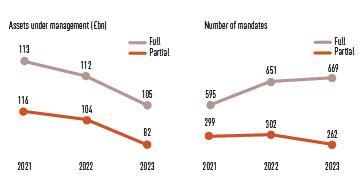The majority of UK-based fiduciary managers’ growth portfolios have underperformed by 3% or more, according to a review by XPS Pensions Group.
The firm conducted a survey of 20 growth portfolios managed by 17 fiduciary managers during 2023 and found that although all portfolios posted positive returns, there was a gap of 12.9% between the highest (13.4%) and lowest-performing (0.5%) portfolios.
Only one fiduciary manager outperformed a traditional 60/40 portfolio across the year, and some underperformed their targets by 3% or more, the research found.
XPS said that there was also a clear link to illiquid allocations and lower absolute returns, noting that the portfolios that were most exposed to illiquid assets such as infrastructure and real estate were most likely to see lower returns.
This was a direct contrast to the experience of fiduciary managers in 2022, when illiquid assets drove higher returns, and could be down to continued tail effects from the Gilt crisis of late 2022, XPS added.
It said that the variable performance came despite a strong year for markets, in which more uniform returns might be expected as fiduciary managers had the opportunity to benefit from rising listed asset prices. It pointed out that the typical global equity portfolios returned 15.7% across the same period.
André Kerr, partner at XPS, said it is “suprirsing” to see this level of variance in the investment performance of fiduciary managers across 2023, despite it being such a strong year for global markets.
He said: “With the government exploring ways to give pension schemes access to surplus, there are now more options for schemes around their endgame, which may change investment calculations.”
Kerr added that schemes should keep a watchful eye on whether the strategy being employed by their fiduciary manager aligns with their investment goals.

However, Ajeet Manjrekar, head of UK client solutions at Schroders, said he is not surprised by this variation as “different managers do things differently”.
He pointed out that some providers favour using a spectrum of illiquid assets and other providers may use some illiquids and then use more liquid assets to have the flexibility to move between the two.
Manjrekar disclosed that Schroders is at the “flexible end”. He said: “We use some illiquids and we use quite a spectrum of liquid assets to give us that flexibility. This way when markets run, you can capture the upside from equities effectively but equally defend accordingly when things go the other way.”
He added that as a result of the Gilt crisis a lot of schemes had to sell their liquid assets to support their hedging strategy. For those schemes that were already a “heavy user” of illiquid assets, this could mean ending up “overweight in illiquid assets” coming out of this period.
He said: “That’s very much reflected in the numbers [in the survey]. You see clearly those who have more illiquid assets missed the ability to capture that upside return.”
He pointed out that illiquid asset performance “takes time to come through” and therefore he expects this picture will “persist for a little while”.
Manjrekar said: “There is more volatility to come in markets, and therefore that’s both risk but also an opportunity, so we might see this divergence continue as a result.”
William Parry, partner in Aon’s investment team, said it is “critical” to assess performance in the context of overall risk.
“This is increasingly important as schemes progress towards their endgames and return targets come down,” he said.
He pointed out that at times when markets oscillate as they have done, looking solely at absolute returns can be misleading.
“At these times, trusting and working with your fiduciary partner to understand the reasons for the performance can be more beneficial than simply assessing the headlines,” he said.
Read the digital edition of IPE’s latest magazine








































No comments yet